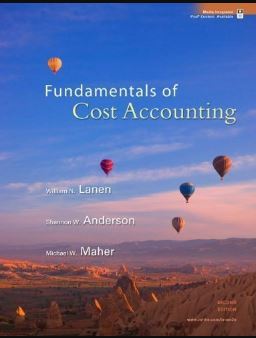
Fundamentals of Cost Accounting 2nd Edition by William Lanen, Carolyn Wells, Michael Maher
Edition 2ISBN: 978-0077274993
Fundamentals of Cost Accounting 2nd Edition by William Lanen, Carolyn Wells, Michael Maher
Edition 2ISBN: 978-0077274993 Exercise 29
Evaluate Profit Impact of Alternative Transfer Decisions
Amazon Beverages produces and bottles a line of soft drinks using exotic fruits from Latin America and Asia. The manufacturing process entails mixing and adding juices and coloring ingredients at the bottling plant, which is a part of Mixing Division. The finished product is packaged in a company-produced glass bottle and packed in cases of 24 bottles each.
Because the appearance of the bottle heavily influences sales volume, Amazon developed a unique bottle production process at the company's container plant, which is a part of Container Division. The Mixing Division uses all of the container plant's production. Each division (Mixing and Container) is considered a separate profit center and evaluated as such. As the new corporate controller, you are responsible for determining the proper transfer price to use for the bottles produced for Mixing Division.
At your request, Container Division's general manager asked other bottle manufacturers to quote a price for the number and sizes demanded by Mixing Division. These competitive prices follow:

a An equivalent case represents 24 bottles.
Container Division's cost analysis indicates that it can produce bottles at these costs:

These costs include fixed costs of $800,000 and variable costs of $4 per equivalent case. These data have caused considerable corporate discussion as to the proper price to use in the transfer of bottles from Container Division to Mixing Division. This interest is heightened because a significant portion of a division manager's income is an incentive bonus based on profit center results.
Mixing Division has the following costs in addition to the bottle costs:

The corporate marketing group has furnished the following price-demand relationship for the finished product:

Required
a. Amazon Beverages has used market price transfer prices in the past. Using the current market prices and costs and assuming a volume of 1.2 million cases, calculate operating profits for:
(1) Container Division.
(2) Mixing Division.
(3) Amazon Beverages.
b. Is this production and sales level the most profitable volume for:
(1) Container Division
(2) Mixing Division
(3) Amazon Beverages
Explain.
Amazon Beverages produces and bottles a line of soft drinks using exotic fruits from Latin America and Asia. The manufacturing process entails mixing and adding juices and coloring ingredients at the bottling plant, which is a part of Mixing Division. The finished product is packaged in a company-produced glass bottle and packed in cases of 24 bottles each.
Because the appearance of the bottle heavily influences sales volume, Amazon developed a unique bottle production process at the company's container plant, which is a part of Container Division. The Mixing Division uses all of the container plant's production. Each division (Mixing and Container) is considered a separate profit center and evaluated as such. As the new corporate controller, you are responsible for determining the proper transfer price to use for the bottles produced for Mixing Division.
At your request, Container Division's general manager asked other bottle manufacturers to quote a price for the number and sizes demanded by Mixing Division. These competitive prices follow:

a An equivalent case represents 24 bottles.
Container Division's cost analysis indicates that it can produce bottles at these costs:

These costs include fixed costs of $800,000 and variable costs of $4 per equivalent case. These data have caused considerable corporate discussion as to the proper price to use in the transfer of bottles from Container Division to Mixing Division. This interest is heightened because a significant portion of a division manager's income is an incentive bonus based on profit center results.
Mixing Division has the following costs in addition to the bottle costs:

The corporate marketing group has furnished the following price-demand relationship for the finished product:

Required
a. Amazon Beverages has used market price transfer prices in the past. Using the current market prices and costs and assuming a volume of 1.2 million cases, calculate operating profits for:
(1) Container Division.
(2) Mixing Division.
(3) Amazon Beverages.
b. Is this production and sales level the most profitable volume for:
(1) Container Division
(2) Mixing Division
(3) Amazon Beverages
Explain.
Explanation
The transfer price is set using any of t...
Fundamentals of Cost Accounting 2nd Edition by William Lanen, Carolyn Wells, Michael Maher
Why don’t you like this exercise?
Other Minimum 8 character and maximum 255 character
Character 255


